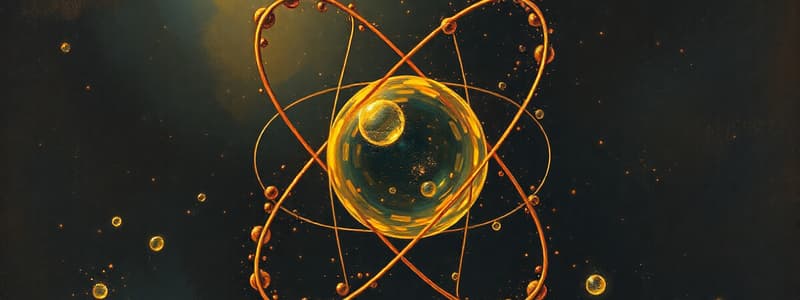Podcast
Questions and Answers
What is the primary role of protons in an atom?
What is the primary role of protons in an atom?
- To facilitate chemical bonding
- To identify the element and its atomic number (correct)
- To neutralize negative charges from electrons
- To determine the atom's mass
Which of the following principles is NOT one of the guidelines for filling electron shells?
Which of the following principles is NOT one of the guidelines for filling electron shells?
- Dalton's law (correct)
- Hund's rule
- Pauli exclusion principle
- Aufbau principle
Which statement about isotopes is correct?
Which statement about isotopes is correct?
- Isotopes of an element have the same number of protons (correct)
- Isotopes have different atomic numbers
- Isotopes are always radioactive
- Isotopes possess different chemical properties
In the context of electron configuration, what does the term 'Aufbau principle' imply?
In the context of electron configuration, what does the term 'Aufbau principle' imply?
What distinguishes cations from anions?
What distinguishes cations from anions?
How is the mass number of an atom defined?
How is the mass number of an atom defined?
Which of the following describes the term 'electron shells'?
Which of the following describes the term 'electron shells'?
What role does the nucleus play in an atom?
What role does the nucleus play in an atom?
Which of the following options is a feature of the periodic table?
Which of the following options is a feature of the periodic table?
What is the outcome of gaining or losing electrons in an atom?
What is the outcome of gaining or losing electrons in an atom?
Flashcards are hidden until you start studying
Study Notes
Atom Structure
-
Basic Definition: The atom is the fundamental unit of matter, composed of subatomic particles.
-
Subatomic Particles:
- Protons:
- Positively charged.
- Located in the nucleus.
- Determines the atomic number and identity of the element.
- Neutrons:
- No charge (neutral).
- Also located in the nucleus.
- Contributes to the atomic mass.
- Electrons:
- Negatively charged.
- Orbit around the nucleus in electron shells.
- Involved in chemical bonding.
- Protons:
-
Nucleus:
- Central part of the atom.
- Contains protons and neutrons.
- Accounts for the majority of an atom's mass.
-
Electron Configuration:
- Arrangement of electrons in shells and subshells.
- Shells are filled according to the Aufbau principle, Pauli exclusion principle, and Hund's rule.
- Determines the chemical properties of an element.
-
Atomic Number (Z):
- Number of protons in the nucleus.
- Unique identifier for each element.
-
Mass Number (A):
- Total number of protons and neutrons in the nucleus.
- Not unique; different isotopes of an element have the same atomic number but different mass numbers.
-
Isotopes:
- Atoms of the same element with different numbers of neutrons.
- Have similar chemical properties but differing masses.
-
Ions:
- Charged atoms formed when atoms gain or lose electrons.
- Cations: Positively charged ions (loss of electrons).
- Anions: Negatively charged ions (gain of electrons).
-
Periodic Table:
- Organization of elements based on atomic number.
- Groups (columns) show elements with similar chemical properties.
- Periods (rows) represent energy levels of electrons.
-
Chemical Bonds:
- Formed due to interactions between electrons of different atoms.
- Types include ionic bonds, covalent bonds, and metallic bonds.
-
Key Concepts:
- The stability and reactivity of an atom depend on its electron configuration.
- Atoms can form molecules through various bonding interactions.
Atom Structure
- The atom is the fundamental unit of matter, composed of subatomic particles: protons, neutrons, and electrons.
- Protons: Located in the nucleus, they have a positive charge and determine the atomic number and element's identity.
- Neutrons: Found in the nucleus, they have no charge (neutral) and contribute to the atomic mass.
- Electrons: Negatively charged particles that orbit the nucleus in electron shells, involved in chemical bonding.
- The atom's nucleus contains protons and neutrons, accounting for most of its mass.
- Electron Configuration: The arrangement of electrons in shells and subshells, following the Aufbau principle, Pauli exclusion principle, and Hund's rule, determines an element's chemical properties.
- Atomic Number (Z): The unique identifier for an element representing the number of protons in its nucleus.
- Mass Number (A): The total number of protons and neutrons in the nucleus. It is not unique as different isotopes of the same element have the same atomic number but different mass numbers.
- Isotopes: Atoms of the same element with the same number of protons but different numbers of neutrons. They have similar chemical properties but differing masses.
- Ions: Charged atoms formed when atoms gain or lose electrons.
- Cations: Positively charged ions, formed by losing electrons.
- Anions: Negatively charged ions, formed by gaining electrons.
- The Periodic Table organizes elements based on their atomic numbers, grouping elements with similar chemical properties in columns and representing energy levels of electrons in rows.
- Chemical Bonds: Formed due to interactions between electrons of different atoms, categorized into ionic bonds, covalent bonds, and metallic bonds.
- An atom's stability and reactivity are determined by its electron configuration.
- Atoms can form molecules through various bonding interactions.
Studying That Suits You
Use AI to generate personalized quizzes and flashcards to suit your learning preferences.




